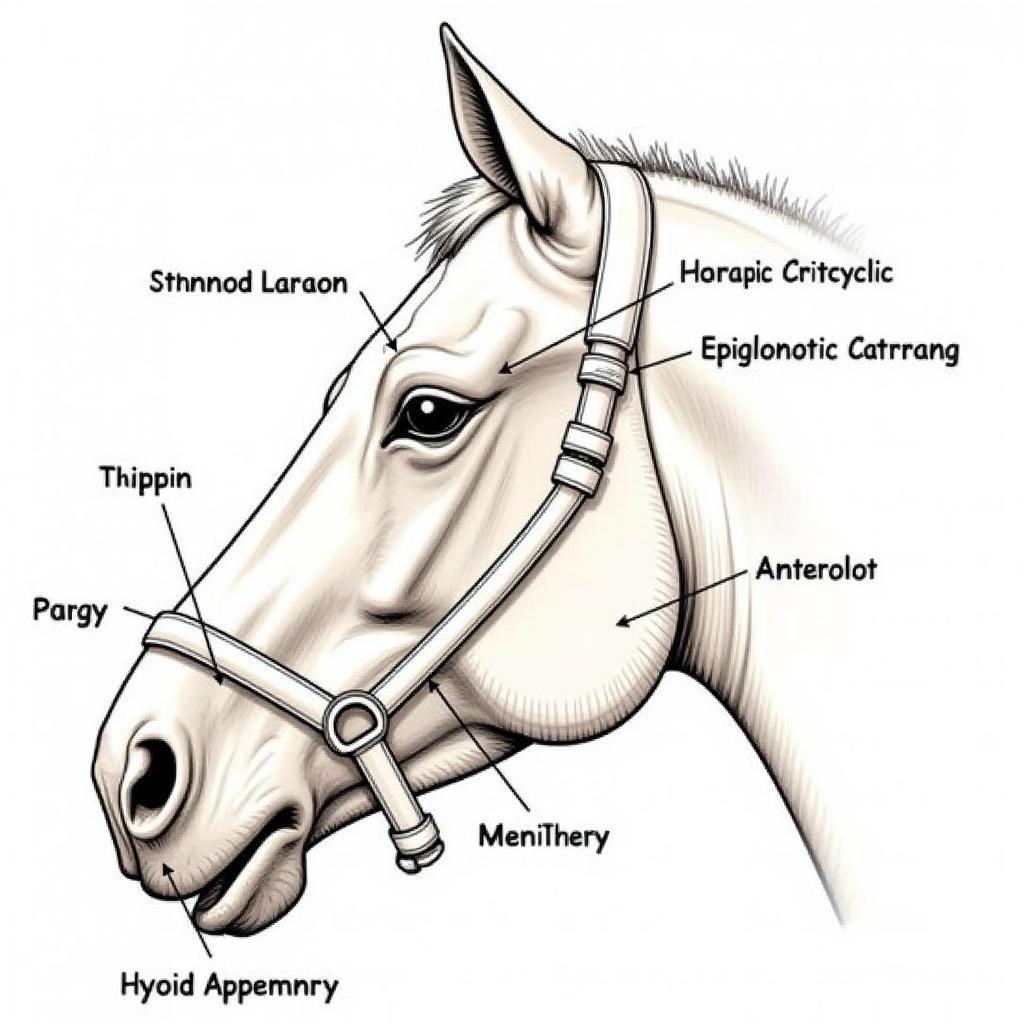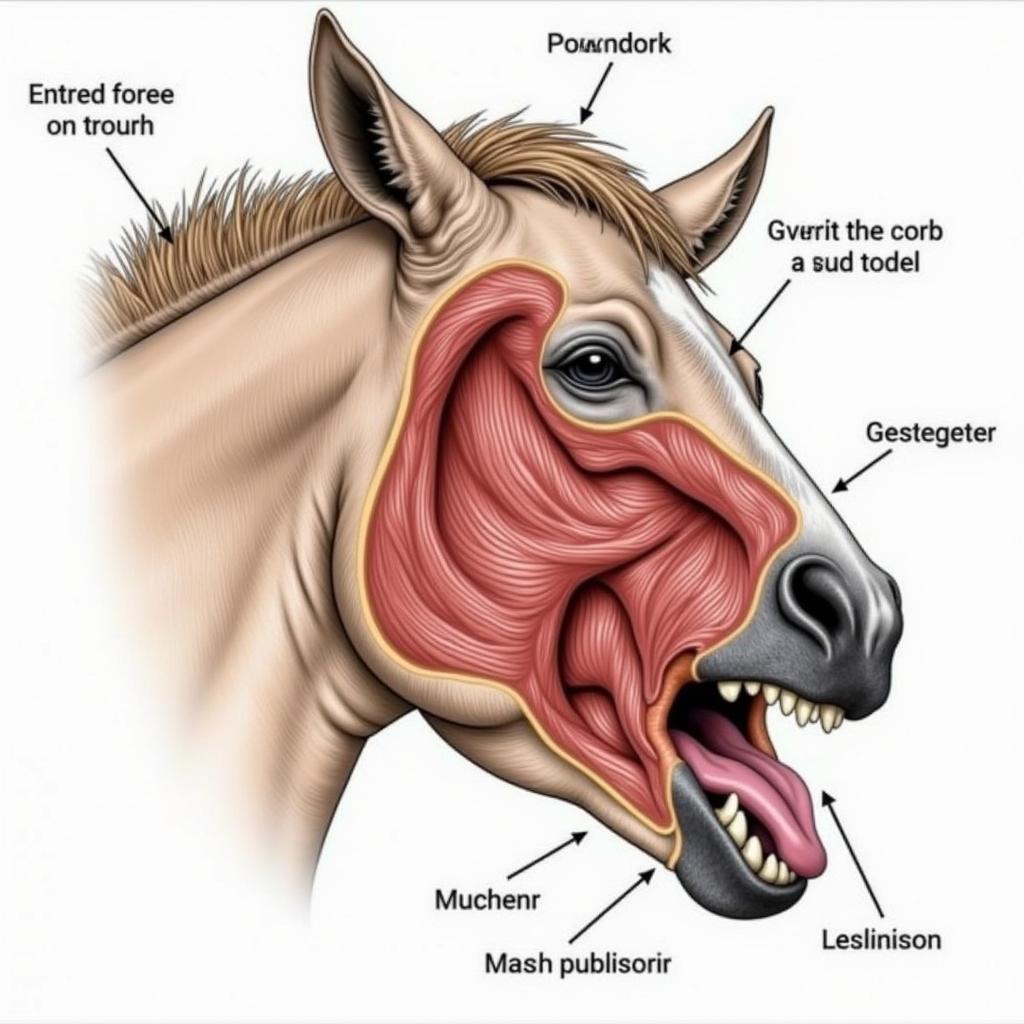The horse larynx, a complex structure of cartilage, muscles, and ligaments, plays a crucial role in breathing, vocalization, and swallowing. Understanding its anatomy is essential for horse owners and professionals alike, allowing for better care and quicker identification of potential issues.
The Cartilaginous Framework: Foundation of the Horse Larynx Anatomy
The horse larynx is primarily composed of several cartilages that provide structure and support. These include the cricoid, thyroid, arytenoid, and epiglottic cartilages. The cricoid cartilage, a complete ring, forms the base of the larynx. The thyroid cartilage, shaped like a shield, protects the vocal folds housed within. The paired arytenoid cartilages, located dorsally, are instrumental in vocal fold movement. The epiglottis, a leaf-shaped cartilage, acts as a lid, preventing food from entering the trachea during swallowing.
 Horse Larynx Cartilages
Horse Larynx Cartilages
The intricate arrangement of these cartilages allows for complex movements facilitated by the laryngeal muscles.
Muscles of the Horse Larynx: Orchestrating Vocalization and Breathing
The intrinsic laryngeal muscles, located within the larynx itself, control the tension and position of the vocal folds, thus regulating airflow and producing sound. These muscles include the cricoarytenoideus dorsalis, which opens the vocal folds for breathing, and the cricoarytenoideus lateralis, which closes the vocal folds for vocalization and protection of the airway.
The extrinsic laryngeal muscles, connecting the larynx to surrounding structures, contribute to the overall positioning and stability of the larynx. These muscles also play a role in swallowing.
Why is Horse Larynx Anatomy Important?
Understanding Horse Larynx Anatomy is crucial for diagnosing and treating various respiratory conditions. For instance, recurrent laryngeal neuropathy (RLN), commonly known as “roaring,” involves paralysis of the laryngeal muscles, affecting breathing and performance. Recognizing the anatomical structures affected by RLN is vital for effective diagnosis and management.
Inside the Larynx: The Vocal Folds
The vocal folds, also known as vocal cords, are two folds of mucous membrane stretched across the larynx. These folds vibrate as air passes through them, producing sound. The tension and position of the vocal folds, controlled by the intrinsic laryngeal muscles, determine the pitch and loudness of the horse’s vocalizations.
What Causes “Roaring” in Horses?
“Roaring” is caused by paralysis of the left arytenoid cartilage and the vocal fold it supports, often due to damage to the left recurrent laryngeal nerve. This paralysis prevents the affected vocal fold from abducting fully during inspiration, obstructing airflow and producing the characteristic roaring sound.
Conclusion: The Importance of Understanding Horse Larynx Anatomy
Understanding horse larynx anatomy is paramount for horse owners, trainers, and veterinarians. This knowledge is essential for recognizing and addressing potential respiratory issues, ensuring the health and well-being of your equine companion. From the intricate cartilaginous framework to the delicate vocal folds, the horse larynx is a complex and fascinating structure, playing a crucial role in breathing, vocalization, and overall health.
FAQ:
-
What is the main function of the horse larynx? The horse larynx is primarily responsible for breathing, vocalization, and preventing food from entering the trachea during swallowing.
-
What are the main cartilages of the horse larynx? The main cartilages are the cricoid, thyroid, arytenoid, and epiglottic cartilages.
-
What are the vocal folds? The vocal folds are two folds of mucous membrane that vibrate to produce sound.
-
What causes “roaring” in horses? “Roaring” is often caused by paralysis of the left arytenoid cartilage due to damage to the left recurrent laryngeal nerve.
-
Why is understanding horse larynx anatomy important? Understanding this anatomy is crucial for recognizing and treating various respiratory conditions.
-
What is the role of the epiglottis? The epiglottis acts as a lid, preventing food from entering the trachea.
-
How do the laryngeal muscles function? The intrinsic laryngeal muscles control vocal fold tension and position for breathing and vocalization, while extrinsic muscles contribute to larynx positioning and stability.
 Horse Larynx Vocal Folds
Horse Larynx Vocal Folds
For further information or assistance, please contact us at Phone Number: 0772127271, Email: [email protected], or visit us at QGM2+WX2, Vị Trung, Vị Thuỷ, Hậu Giang, Việt Nam. We have a 24/7 customer service team.